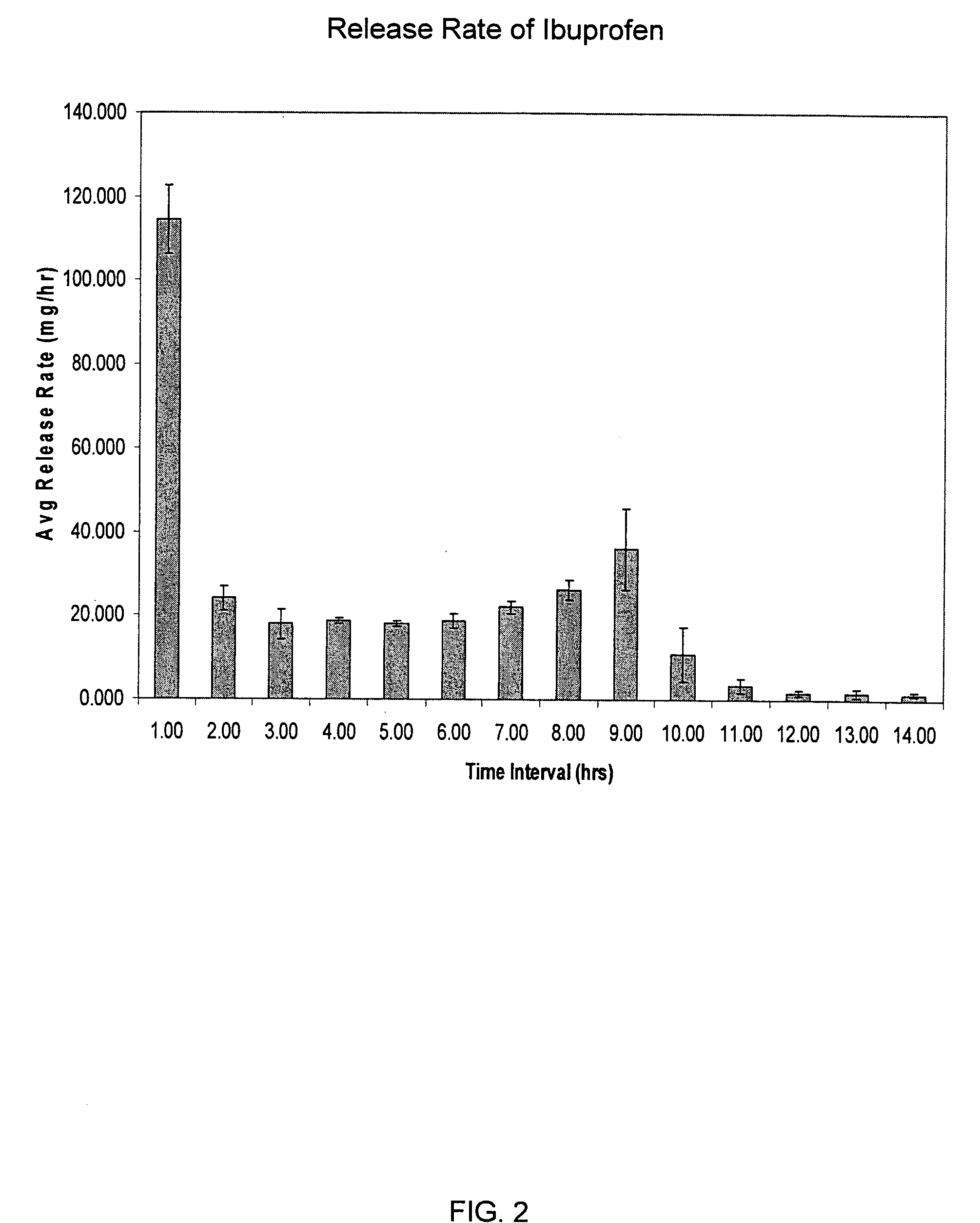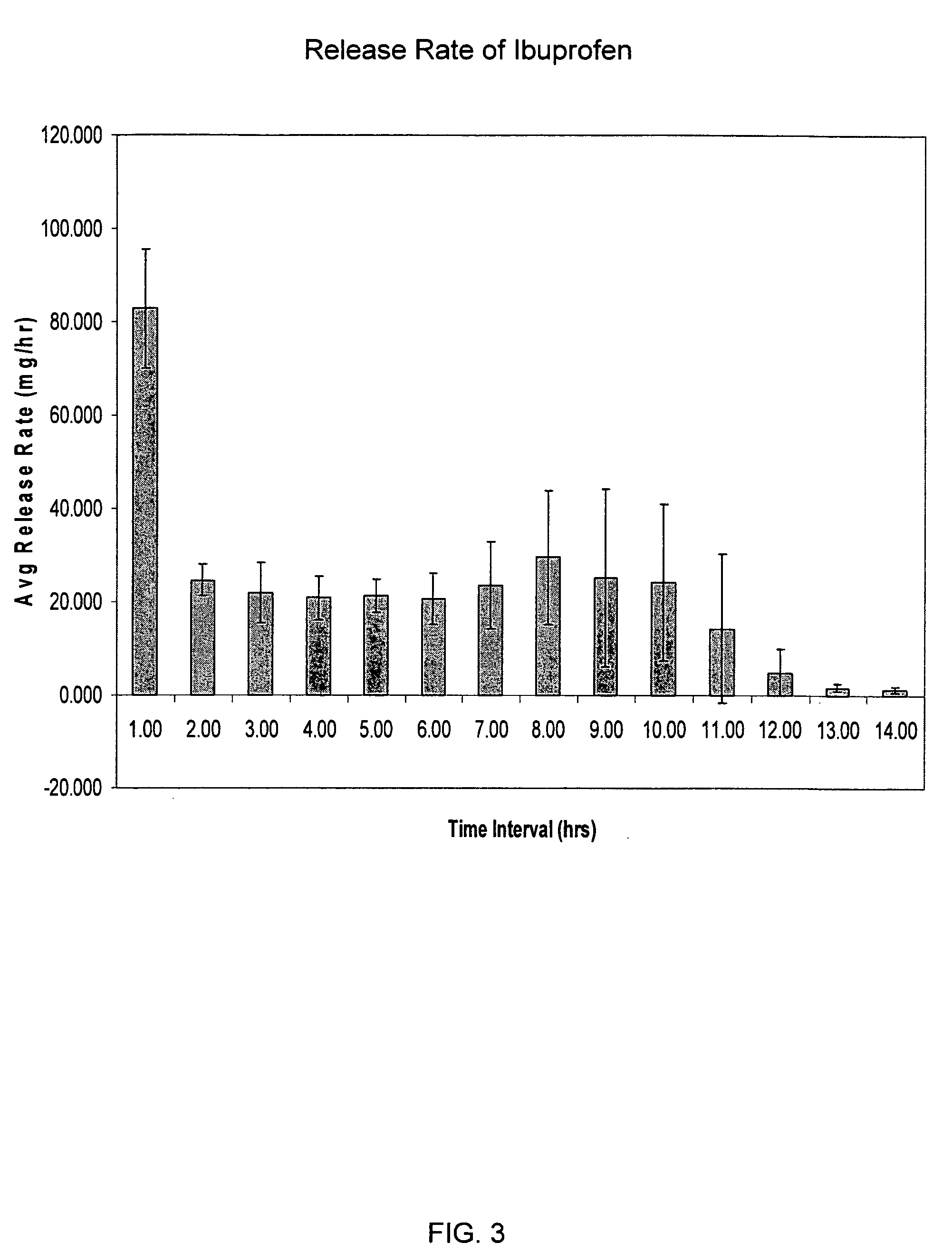Oros push-stick for controlled delivery of active agents
a push-stick and active agent technology, applied in the direction of osmotic delivery, microcapsules, capsule delivery, etc., can solve the problems of complex compositions, complex compositions, and increased drug loading, and achieve the effect of fast initial rate of releas
- Summary
- Abstract
- Description
- Claims
- Application Information
AI Technical Summary
Benefits of technology
Problems solved by technology
Method used
Image
Examples
example 1
[0169] A general procedure for preparing the sustained release dosage forms is as follows:
Preparation of the Drug Layer Granulation
[0170] A binder solution is prepared by adding binding agent (hydroxypropyl cellulose, “HPC” (e.g., Klucel MF, Aqualon Company), or polyvinylpyrrolidone) to water to form a solution containing 5 mg of HPC per 0.995 grams of water. The solution is mixed until the hydroxypropyl cellulose is dissolved. For a particular batch size, a fluid bed granulator (“FBG”) bowl is charged with the required amounts of active agent (e.g., ibuprofen at about 80.0% by weight), binding agent (e.g., polyethylene oxide (MW 200,000) (Polyox® N-80, Union Carbide Corporation), disintegrant (e.g., croscarmellose sodium or crospovidone), optionally surfactant (e.g, polyoxyl 40 stearate or SDS) and osmagent (e.g., sorbitol or mannitol). After mixing the dry materials in the bowl, the binder solution prepared as above is added. Then the granulation is dried in the FBG to a consis...
example 2
[0183] A dosage form containing 350 mg ibuprofen was prepared using the procedures generally described in Example 1. The drug layer composition consisted of the following components: 85 wt % ibuprofen (USP, 38 micron), 6 wt % HPC(NF, Ph Eur), 6 wt % croscarmellose sodium, NF, 2 wt % sodium lauryl sulfate, NF, 0.5 wt % colloidal silicon dioxide, NF, 0.5 wt % magnesium stearate, NF. The push layer contained the following components: 63.67 wt % polyethylene oxide (7000K, NF), 30.0 wt % NaCl, 5 wt % povidone USP, Eur (K29-32), 1 wt % magnesium stearate, NF, Ph Eur, JP, 0.25 wt % ferric oxide, NF, 0.08 wt % BHT, NF. The semipermeable membrane was composed of 80 wt % cellulose acetate, NF (398-10) and 20 wt % poloxamer 188, NF. The orifice size was 155 mils (3.937 mm).
[0184] This dosage form produced an initial average rate of release of ibuprofen of 99.5 mg / hr for the first hour, followed by a roughly zero order release rate of about 25 mg / hr sustained for 10 hours, then rapidly droppin...
example 3
[0185] A dosage form containing 350 mg ibuprofen was prepared using the procedures generally described in Example 1. The drug layer composition consisted of the following components: 85 wt % ibuprofen (USP, 38 micron), 5 wt % HPC(NF, Ph Eur), 3 wt % croscarmellose sodium, NF, 3 wt % sodium lauryl sulfate, NF, 3 wt % sorbitol, NF (powder), 0.5 wt % colloidal silicon dioxide, NF, 0.5 wt % magnesium stearate, NF. The push layer contained the following components: 63.67 wt % polyethylene oxide (7000K, NF), 30.0 wt % NaCl, 5 wt % povidone USP, Eur (K29-32), 1 wt % magnesium stearate, NF, Ph Eur, JP, 0.25 wt % ferric oxide, NF, 0.08 wt % BHT, NF. The semipermeable membrane was composed of 80 wt % cellulose acetate, NF (398-10) and 20 wt % poloxamer 188, NF. The orifice size was 155 mils (3.937 mm).
[0186] This dosage form produced an initial average rate of release of ibuprofen of 77.7 mg / hr for the first hour, followed by a roughly zero order release rate of about 29 mg / hr sustained for ...
PUM
| Property | Measurement | Unit |
|---|---|---|
| solubility | aaaaa | aaaaa |
| weight percent | aaaaa | aaaaa |
| time | aaaaa | aaaaa |
Abstract
Description
Claims
Application Information
 Login to View More
Login to View More - R&D
- Intellectual Property
- Life Sciences
- Materials
- Tech Scout
- Unparalleled Data Quality
- Higher Quality Content
- 60% Fewer Hallucinations
Browse by: Latest US Patents, China's latest patents, Technical Efficacy Thesaurus, Application Domain, Technology Topic, Popular Technical Reports.
© 2025 PatSnap. All rights reserved.Legal|Privacy policy|Modern Slavery Act Transparency Statement|Sitemap|About US| Contact US: help@patsnap.com



